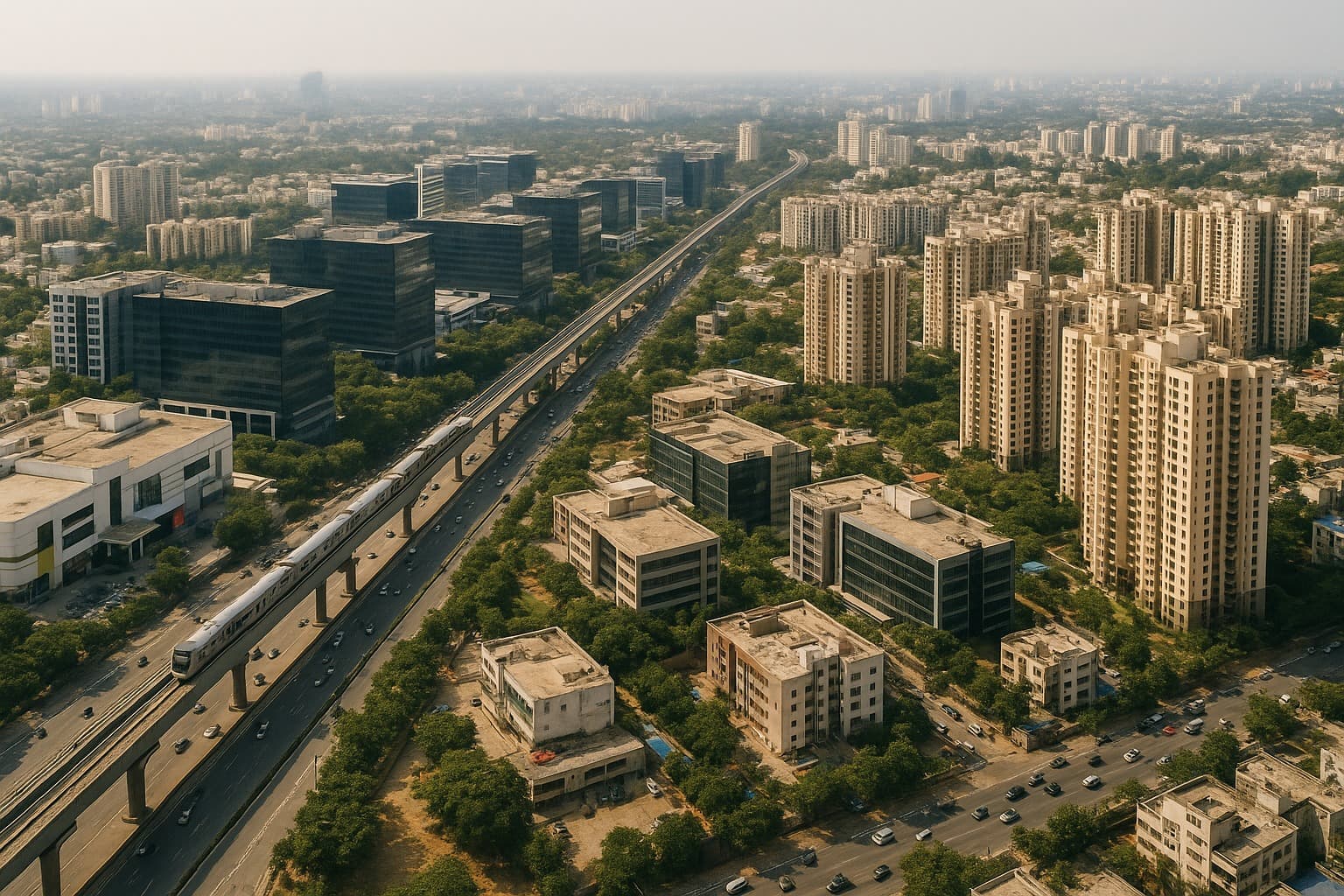2025's Biggest Real Estate Growth Drivers in India
Summary
India's 2025 real estate boom is driven by infrastructure, urbanization, FDI, and employment hubs. Affordable and premium housing, smart city projects, and supportive policies fuel growth for buyers and investors.

The Indian real estate sector is entering a pivotal phase in 2025. After years of fluctuating demand, pandemic disruptions, and economic uncertainty, several key real estate growth India drivers are converging to create an unprecedented boom. From urbanisation and employment hubs to FDI inflows and smart city projects, the landscape is evolving rapidly. Both metro and tier-2 cities are witnessing strong buyer and investor interest, making property growth 2025 a phenomenon shaped by multiple interlinked forces. Understanding these drivers is crucial for developers, buyers, and investors aiming to navigate India’s dynamic housing market.
Infrastructure Development: Laying the Foundation
Infrastructure remains a critical housing demand driver in India. Projects like highways, metro lines, expressways, and airports are redefining urban and suburban property markets. Improved connectivity drives real estate trends India, allowing peripheral areas to become viable residential and commercial options.
For instance, metro expansions in cities like Pune, Bengaluru, and Hyderabad have boosted property growth 2025, making areas once considered remote attractive for homebuyers. New airports, expressways, and industrial corridors create drivers of housing market recovery India by opening up untapped land and encouraging mixed-use development. Developers are keenly targeting these zones, offering integrated townships, gated communities, and affordable housing projects to meet rising demand.
FDI and Investor Confidence
Foreign Direct Investment (FDI) plays a major role in shaping Indian housing sector growth. Increased FDI in real estate brings global capital, advanced construction practices, and innovative designs, raising standards across residential and commercial developments.

Domestic investor confidence is also recovering strongly. Millennials and first-time homebuyers, combined with NRIs, are driving demand in both metro and emerging cities. Real estate investment trends for 2025 show growing interest in both premium and affordable segments. Investors are betting on areas with strong infrastructure, employment hubs, and high rental yields, reflecting a market-wide optimism that is a critical factor driving property market growth in India.
Urbanisation and Rising Housing Demand
Rapid urbanisation is one of the most significant housing demand boosters in Indian real estate 2025. Cities are expanding, and migration from tier-2 and tier-3 towns is pushing up demand for residential, commercial, and rental properties.
This population surge is reshaping real estate trends India, driving demand for affordable apartments, compact homes, and township projects. Urban expansion also encourages commercial real estate growth, as businesses seek locations close to residential clusters. Developers are responding with smartly planned communities offering amenities like schools, hospitals, and retail spaces, reflecting the evolving Indian housing sector landscape.
Employment Hubs: Driving Residential Demand
Job creation centers, particularly IT and industrial corridors, are proving to be strong real estate growth India drivers. Cities with high employment growth see a direct impact on housing demand.
In Bangalore, Pune, Gurugram, and Hyderabad, housing demand boosters in Indian real estate 2025 are clearly linked to the rise of IT parks, corporate offices, and industrial zones. Residential projects near these hubs cater to employees seeking convenience, while investors eye long-term capital appreciation. This connection between job hubs and property markets is a critical factor shaping real estate demand in Indian cities 2025, influencing where developers choose to launch new projects.
Affordable and Premium Segment Growth
The Indian market is witnessing a unique dual growth trend. Affordable housing remains the mainstay, especially in tier-2 and tier-3 cities, while premium and luxury segments expand in metro regions and high-end townships.
Government initiatives, such as tax incentives, low-interest home loans, and subsidies for affordable housing, are supporting volume sales. Meanwhile, major trends fueling Indian real estate growth in 2025 include high-end apartments, villas, and integrated townships targeting NRIs and premium buyers. This balance ensures a diverse market where both first-time homebuyers and seasoned investors find opportunities.
Smart Cities and Technology-Driven Development
Smart city initiatives and technology-enabled urban planning are changing the way real estate functions in India. Key real estate growth drivers in India for 2025 include sustainable, energy-efficient buildings, IoT-enabled homes, and eco-friendly construction practices.
Smart infrastructure enhances property growth 2025, offering buyers modern amenities, improved civic services, and better living experiences. Developers investing in these areas not only attract end-users seeking lifestyle benefits but also investors looking for long-term capital appreciation. Sustainability and technology are no longer optional—they are integral to shaping real estate trends India in 2025.
Co-Living and Rental Housing
The rise of co-living spaces and rental housing has emerged as a subtle yet impactful real estate growth India driver. Young professionals, students, and migrant workers are increasingly opting for shared living, creating demand for rental-ready units and flexible housing solutions.

Post-pandemic changes have shifted buyer priorities toward larger homes, work-from-home-friendly layouts, and gated communities. Housing demand boosters in Indian real estate 2025 now include lifestyle-driven factors that influence both rental and purchase decisions. Investors are responding by developing co-living projects and rental-ready units near employment hubs, transport corridors, and smart city zones.
Policy and Regulatory Support
Government regulations underpin the stability and growth of the Indian housing sector. Policies such as RERA, tax incentives, and fast-track approvals for affordable housing and infrastructure projects strengthen Indian housing sector fundamentals.
These measures build buyer and investor confidence, supporting factors driving property market growth in India. A transparent regulatory environment minimizes risk, encourages formal investment, and boosts drivers of housing market recovery India, ensuring sustainable growth across metro and tier-2 cities.
Conclusion
The Indian real estate market in 2025 is being shaped by a combination of infrastructure development, urbanisation, FDI inflows, job hubs, and technology-driven smart projects. Affordable and premium housing segments are growing simultaneously, while co-living and rental options cater to evolving buyer preferences. Government support and policy stability provide the necessary assurance for sustained investment. Understanding these key real estate growth drivers in India for 2025 is essential for developers, investors, and homebuyers looking to capitalize on a market experiencing robust transformation and long-term growth potential.
Summary (100 words)
India’s real estate growth in 2025 is being fueled by multiple intertwined drivers. Infrastructure developments, including metro expansions, highways, airports, and expressways, are increasing accessibility and unlocking new property zones. FDI inflows and domestic investor confidence are bolstering both residential and commercial segments. Urbanisation, employment hubs, co-living trends, and smart city initiatives are further shaping Indian housing sector demand. Affordable housing continues to see volume growth, while premium segments expand in metros. Policy support through RERA, tax incentives, and approvals enhances transparency and confidence. Together, these factors are making property growth 2025 dynamic, sustainable, and attractive for buyers and investors alike.
